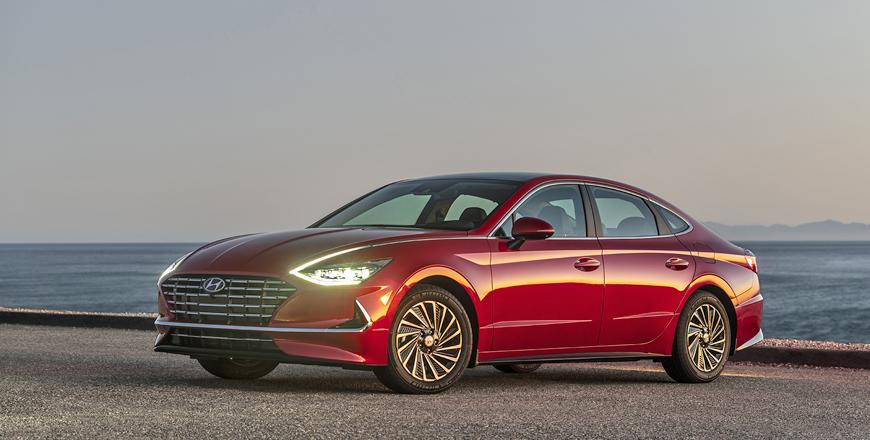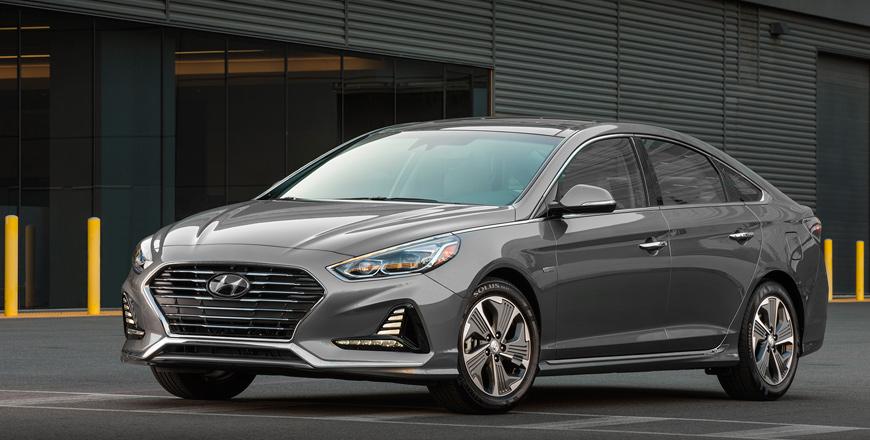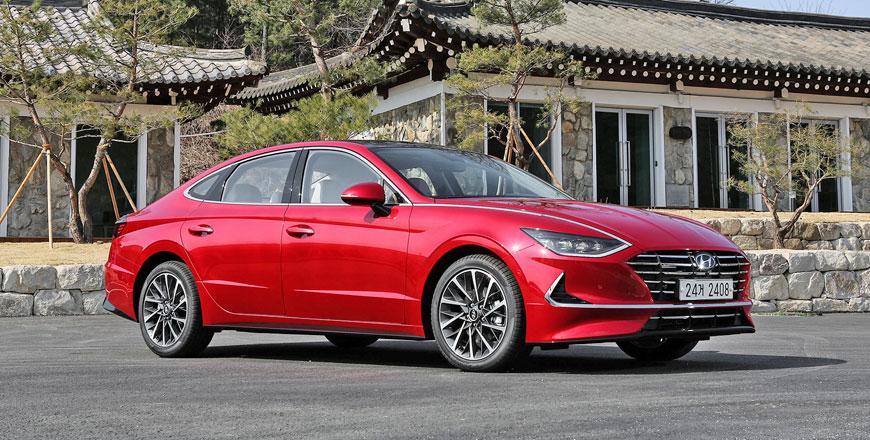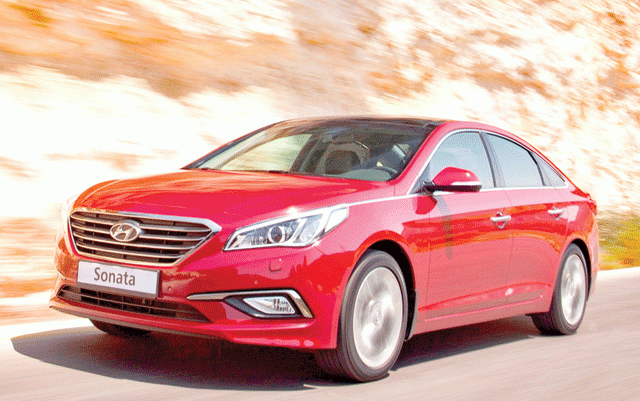You are here
Hyundai Sonata Hybrid: Smooth, stylised and low-slung saloon
By Ghaith Madadha - Mar 14,2022 - Last updated at Mar 14,2022

Photo courtesy of Hyundai
An assertively stylised and dramatic design departure from its conservative predecessor, the eight Hyundai Sonata instead harks back to the radically rakish sixth generation model. Introduced in 2019 under the Korean brand’s more individualistic “Hyundai look” approach, the new Sonata gained new tech and incrementally improved driving dynamics, cabin, comfort and materials. However, and more pertinent to the Jordanian market, where it is the sole version available, the Sonata Hybrid arrived the following year, with similarly yet subtly improved drive-line integration and efficiency.
Dramatic direction
A design-led car informed by trendy so-called “four-door coupes” like the Audi A7 and Mercedes-Benz CLS-Class, Hyundai’s ambitious goal for the new Sonata is to produce “the most beautiful sedan on the road”. Whether this is so is a matter of personal taste, but it is indeed an attractive, low-slung and viscerally dramatic design. Longer, lower and wider than predecessors, it is meanwhile built on a new platform with repositioned front strut towers for a lower bonnet, shorter front overhang and longer wheelbase.
A front-driven car with a similarly sporty profile as more up-market rear-drive saloons in its overhang and wheel hub to A-pillar length ratios, the new Sonata’s design meanwhile seems aesthetically inspired by marine life, with its broad shoulders, wide stance, sharply creased lines and heavily ridged surfacing somewhat resembling a stingray. However, its wide, almost frowning “cascading grille” design, protruding lower lip and long, low, arcing — almost fastback — roofline and discrete rear light cluster fins instead evoke a more menacingly dramatic barracuda-like sensibility.
Confident combo
Aggressively styled for a mainstream eco-oriented family saloon, the Sonata Hybrid is no outright performance saloon, but nevertheless packs a decent punch when both combustion engine and electric motor are operating in unison. Producing 150BHP at 6,000rpm and 139lb/ft 5,000rpm from its naturally-aspirated 2-litre 4-cylinder petrol engine and 51BHP at 1,800-2,300rpm and 151lb/ft at 0-1,800rpm from its electric motor, it can develop a meaningfully effective combined output of 192BHP at 6,000rpm and up to an estimated 270lb/ft as low as 1,800rpm.
Flexible and muscular riding its substantial low- to mid-range torque band, the Sonata Hybrid accelerates through 0-100km/h in around 9-seconds and overtakes authoritatively. Confident on fast inclines for shorter bursts, it, however, loses some versatility when driven through sustained, high power hill climbs, as batteries deplete and the combustion engine is left to almost single-handedly haul its estimated 1.6-tonnes under such demanding conditions. That said, the Sonata Hybrid is comparatively quick recharging its batteries from the combustion engine and regenerative braking.
Cruising comfort
Improving on its predecessor, the new Sonata Hybrid seemingly allows slightly longer EV driving and smoother electric-combustion integration. From full throttle lift-off, its electric motor seems quicker to wind down, but lacks a combustion engine’s immediacy in cutting power. Returning frugal estimated 5l/100km combined fuel efficiency, the Sonata Hybrid drives its front wheels through a 6-speed automatic gearbox. Smooth shifting and responsive to single ratio manual input downshifts, it, however, isn’t as slick or quick as the non-hybrid Sonata’s 8-speed automatic.
Comfortable, quiet and stable on highway and in town, the Sonata Hybrid is a natural long distance cruiser that smoothly irons out most road imperfections, but is slightly firm in primary reactions to particularly jagged lumps and bumps, due to sporty low profile 215/55R17 tyres. Easy to manoeuvre with light electric-assisted steering, the Sonata’s rear view camera and parking sensors meanwhile compensate for its low roofline’s reduced rear visibility. Steering is meanwhile accurate and well-damped, but not especially nuanced for road feel.
Less clutter, more class
Better handling and with better body control than predecessors, the Sonata Hybrid is best driven at a moderate, or brisk but within comfort zone pace, rather than at its dynamic limits. Tuned for smoothly pliant comfort, the Sonata Hybrid might benefit from slightly firmer vertical compression and rebound control over crests and dips. Tidy turning in, its grip limits are meanwhile better communicated with electronic stability control in ‘off’ position, but which is perhaps over-cautious when fully engaged, with early intervention through hard driven corners.
Plusher, better equipped and more advanced than its predecessor, the new low-slung Sonata features a cleaner, less cluttered and airier interior, emphasising horizontal lines and utilising an un-obstructive push-button shift-by-wire gear selector and reduced button count, with most features accessed through a wide 12.3-inch touchscreen. Incorporating better materials and softer textures, it is comfortable inside, with good cabin width, legroom and luggage volume. However, given a rakish roofline, perhaps slightly lower seat mounting points would be welcomed by taller occupants, especially in sunroof-equipped models.
TECHNICAL SPECIFICATIONS
Engine: 2-litre, transverse 4-cylinders, & parallel electric motor
Bore x stroke: 81 x 97mm
Compression ratio: 14:1
Valve-train: DOHC, 16-valve, continuously variable valve timing, direct injection
Gearbox: 6-speed automatic, front-wheel-drive
Gear ratios: 1st 4.639:1; 2nd 2.826:1; 3rd 1.841:1; 4th 1.386:1; 5th 1.0:1; 6th 0.772:1
Reverse/final drive: 3.385:1/3.51:1
Electric motor: Permanent magnet synchronous
Battery: lithium-ion polymer
Battery voltage/capacity/output: 270V/1.62kWh/kW
Petrol engine power, BHP (PS) [kW]: 150 (152) [112] @6,000 rpm
Electric motor power, BHP (PS) [kW]: 51 (52) [39] @1,800-2,300rpm
Combined power, BHP (PS) [kW]: 192 (195) [143] @6,000rpm
Petrol engine torque, lb/ft (Nm): 139 (188) @5,000rpm
Electric motor torque, lb/ft (Nm): 151 (205) @0-1,800rpm
Combined torque, lb/ft (Nm): 270 (367) @1,800rpm (estimate)
0-100km/h: 9-seconds (estimate)
Fuel consumption, city/highway/combined: 5.2-/4.6-/5-litres/100km*
Fuel capacity: 50-litres
Length: 4,900mm
Wheelbase: 2,840mm
Track, F/R: 1,623/1,630mm
Minimum ground clearance: 135mm
Aerodynamic drag co-efficiency: 0.24
Luggage volume: 453-litres
Doors/seats: 4/5
Kerb weight: 1,508-1,601kg (estimate)
Steering: Electric-assisted rack and pinion
Steering ratio: 13.27:1
Lock-to-lock: 2.6-turns
Turning circle: 10.97-metres
Suspension, F/R: MacPherson struts/multi-link
Anti-roll bar, F/R: 21.8mm/18mm
Brakes F/R: Ventilated discs, 304mm/discs, 284mm, regenerative braking
Tyres: 215/55R17
*US Environmental Protection Agency estimates
Related Articles
By Ghaith Madadha Among Jordan’s most popular mid-size saloons, the Hyundai Sonata Hybrid is a comfortable, smooth and refined cruiser
A far more dramatic and stylised car than the somewhat conservative model it replaces, the new eight generation Hyundai Sonata takes a disti
A follow-up to Hyundai’s radically styled sixth generation Sonata circa 2010, the new 2015 model year seventh generation is an evolutionary but thoroughly redesigned, made-over new model with significant engineering improvements.


















